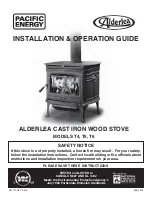
3. Clean the filter in the control valve if necessary.
4. Check the flue for soot and clean if necessary.
Check all flue joints seals and reseal if required.
5. Check for oil leaks at all fittings.
6. Light the stove (checking the ignition system).
Check that the flue stabiliser is operating cor-
rectly and that the flame pattern is acceptable.
Blanking Nut
Fig.23
17
(c) Check for flue or chimney blockage and clean
if required.
(d) Do not attempt to relight the fire until the cause
of the fume emission has been identified and
corrected. If necessary seek expert advice.
The most common cause of fume emission is flueway
or chimney blockage. For your own safety
these must be kept clean at all times.
This appliance is hot while in operation and retains its
heat for a long period of time after use. Children,
aged or infirm persons should be supervised at all
times and should not be allowed to touch the hot
working surfaces while in use or until the appliance
has thoroughly cooled.
If the stove does not work properly during certain
adverse weather conditions, switch the stove off.
Have the installation inspected by your locals service
engineer who will make recommendation on how to
rminimise the effect of adverse weather conditions on
the stove.
The flue draught stabiliser located on the back of the
stove is set by the engineer during commissioning of
the appliance. The user should not adjust the draught
stabiliser as it will effect the performance of the stove.
CO ALARM
Waterford Stanley recommend the fitting of a CO
Alarm in the same room as the appliance.
Further guidance on the installation of a carbon
monoxide alarm is available in BS EN 50292:2002
and from the alarm manufacturers instructions.
Provision of an alarm must not be considered a
substitute for either installing the appliance correctly
or ensuring regular servicing and maintenance of the
appliance and chimney system.
WARNING:-
If the CO Alarm sounds unexpectedly:-
1.
Shut off the appliance.
2. Open Doors and windows to ventilate the room
and then leave the premises.
FIRE SAFETY
To provide reasonable fire safety, the following
should be given serious consideration:
1. Install a smoke detector in the room.
2. A conveniently located class A fire extinguisher to
contend with small fires resulting from burning
embers.
3. A practical evacuation plan.
4. A plan to deal with a chimney fire as follows:-
(a) Notify the fire department.
(b) Prepare occupants for immediate
evacuation.
(c) Turn off the stove and the oil supply.
(d) While awaiting the fire department watch
for ignition to adjacent combustibles from
overheated flue pipe or from embers or sparks
from the chimney.
WARNING:
Properly installed, operated and maintained this
stove will not emit fumes into the dwelling.
Persistent fume emission is potentially dangerous and
must not be tolerated. If fume emission does persist,
then the following immediate action should be taken:
(a) Turn off the stove
(b) Open doors and windows to ventilate room and
then leave the premises.




































